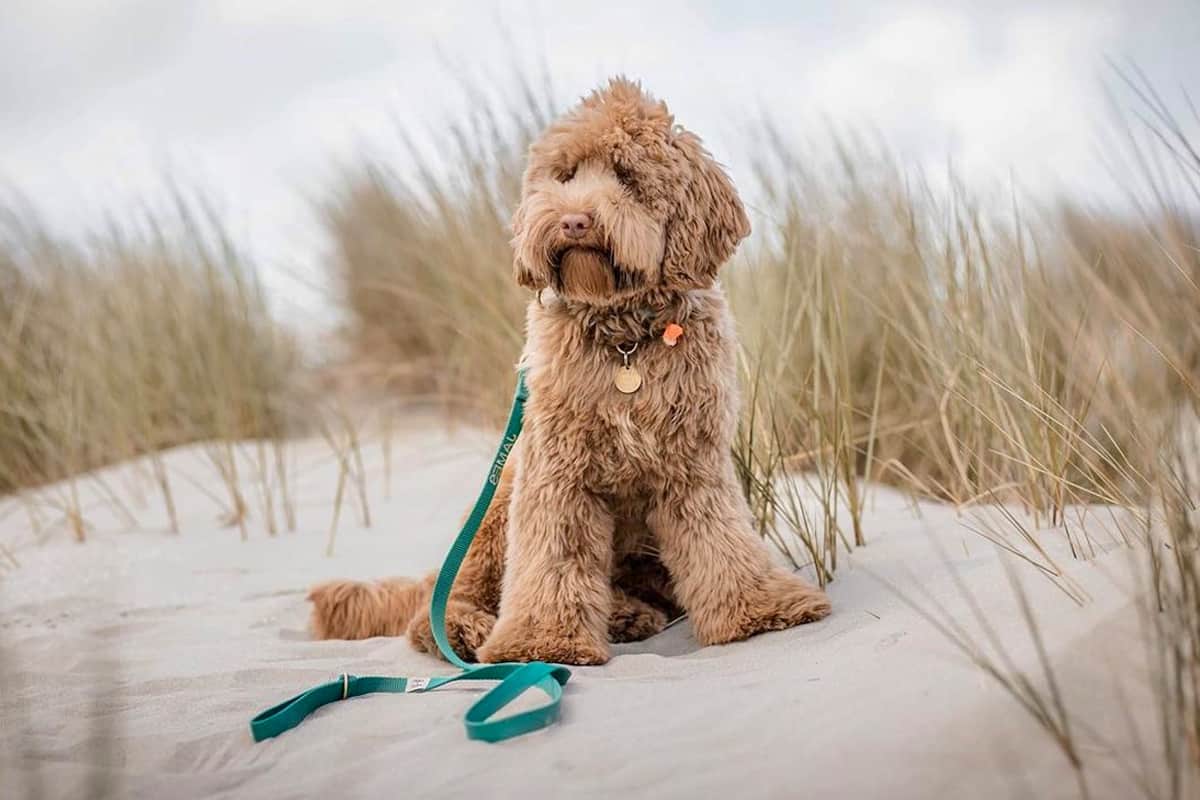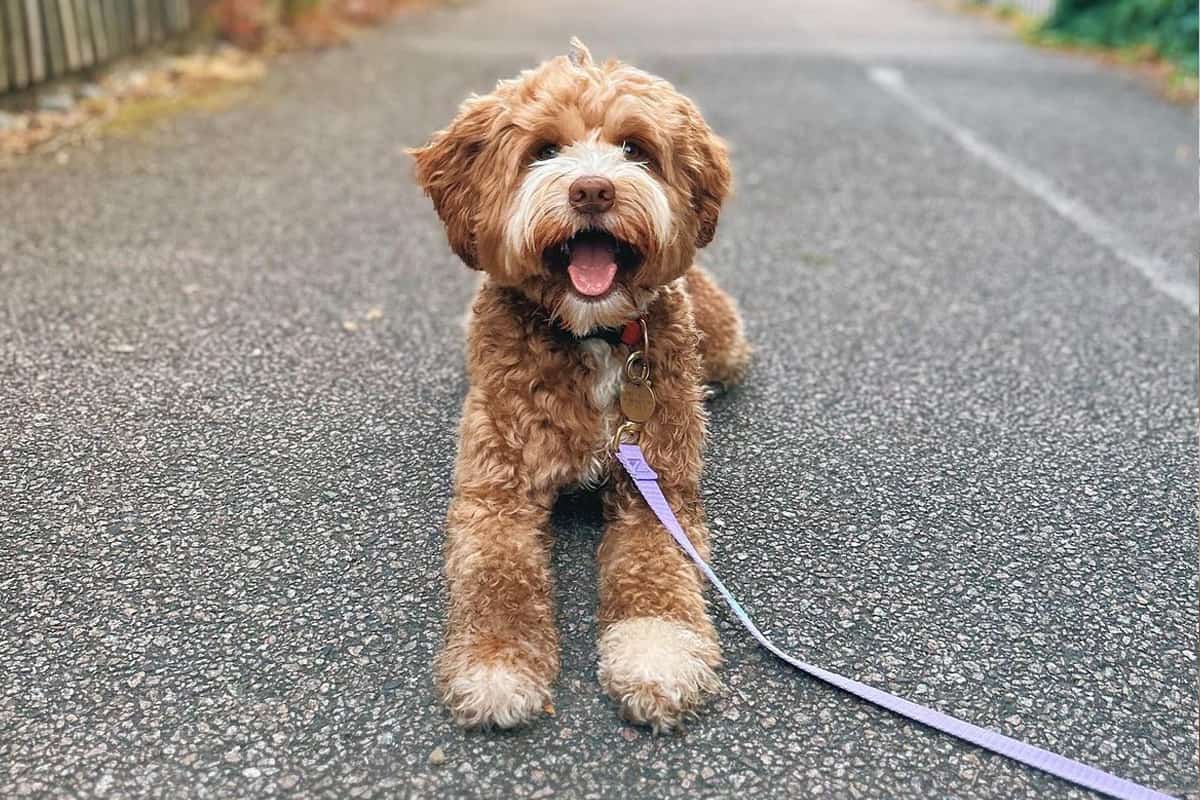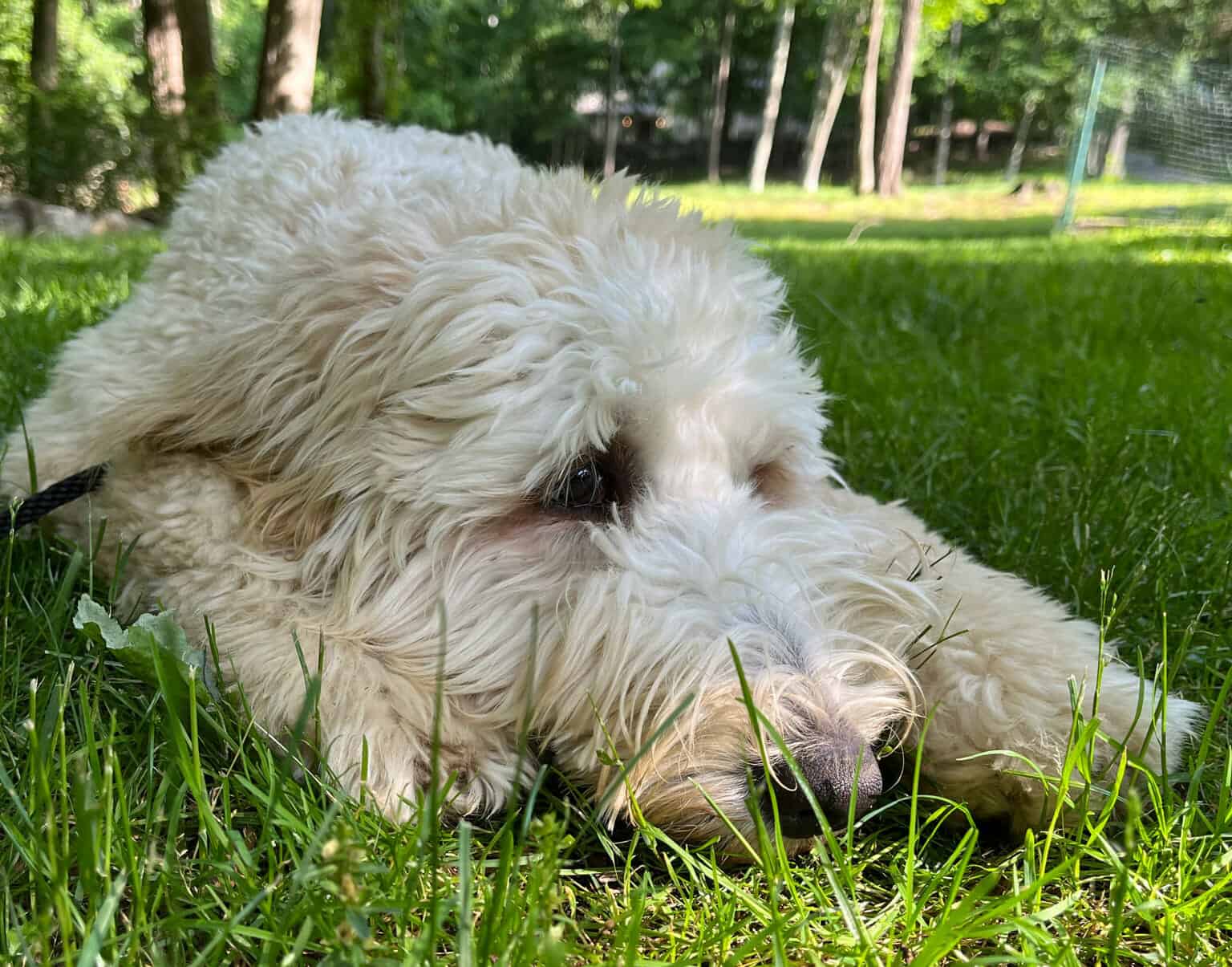Teaching your dog to come every time you call is perhaps the most important training you can do. Professional dog trainers refer to this as ‘Recall Training”, and it happens to be my favorite behavior to work on. A fast, happy, reliable “Recall” allows you to take your dog more places and give them more freedom and fun.
Recall Training: Why Most Puppy Owners Are Doing It All Wrong
“Come” is a super easy behavior to teach a doodle puppy. Young pups are inclined to follow us, and so if you call your puppy in a happy voice, perhaps crouching down or clapping your hands to entice them, they will likely come bounding joyfully to you.
The problem is that the majority of puppy owners – I was once guilty of this too! – set about ruining their “Come” cue almost immediately. How?
Right away, we only start to ask for “Come” when we need it.
To call our dogs away from something fun. To leash them up and take them out of the park. To bring them inside and put them in the crate.
Dogs are brilliant at predicting patterns, and associating their actions with positive or negative consequences. And many doodle puppies learn early on that “Come” usually predicts the End Of Fun.
In addition, we allow the puppy to learn there is another, more rewarding option – when they ignore the “Come” cue, they are able to continue the fun they were having and perhaps be extra rewarded with a thrilling game of chase the puppy!
After this thrilling-for-the-pup, frustrating-for-you game of catch me if you can, if your puppy finally does come you are now angry with him. You clip the leash on, and march him inside.
Womp, Womp, Womp. :/
Doodle dogs like to party. And all animals do or don’t do behaviors based on whether the consequences are rewarding or punishing. Are you starting to see why so many dogs aren’t too keen on “Come?”
As I have said before, I was guilty of many of the same common training mistakes with my very first dog, Tino. As a result, his Recall was not stellar. He knew the word “Come” and would usually listen… unless he was distracted… or having too much fun… or he just didn’t want to…
A funny thing, though. If I were to say “Tino, want to go for a ride?”
He would run to me every time.
Why? Because he had learned through experience that those particular words reliably predicted something he enjoyed very much. A strong history of reinforcement produced a reliably urgent, happy response to those words.
I know I’m not alone – many pet owners inadvertently teach their dog a pretty reliable recall cue – “Walk” “Treat” “Chicken”. Perhaps just jingling the leash. Sometimes by the time I am called in to help, owners have resorted to using these words to ‘trick’ their doodle into coming to them.
The problem is, doodle dogs are smart. After using these words once or twice, then failing to deliver the goods and instead, ending the dog’s fun, they aren’t going to work anymore. Fool me once, as they say.

How To Get a Million Dollar Recall
As I said earlier – training a great Recall is perhaps the most valuable and beneficial skill you can impart to your doodle dog. And any great skill takes time and practice to achieve. It is unrealistic to expect your dog to master the recall right away and then be reliable forever. And it’s pretty wishful thinking to expect your dood to come every time you call “just because you said so”.
Instead, commit to building a strong, solid reward history for your dog to the word “Come”. Consider the recall training in this article like accruing a bank account of positive consequences for your dog for responding to “Come”. Every day, aim to put a few great repetitions into your account, and try to make very few withdrawals.
Meaning, don’t use the word “Come” for lame stuff.
“Well, what about when I need my dog to come inside from playing? Or to go in their crate? Or take a bath? Or come away from something yucky / questionable / dangerous (aka Awesome!)?”
The answer is simple, and you’ll find it at the beginning of every effective training program:
Management
Management in training means we take measures to prevent the dog from practicing and being reinforced for what we Don’t want, while we teach and reinforce them for the behavior we Do want.
While your doodle is still in training, he should be wearing a leash at all times. Even if you have a fenced-in yard, before their recall is solid, have your pup drag a long, lightweight training leash when playing. If you need to get your dog for something they don’t find rewarding, simply find the end of the leash and guide them to you.
Again, avoid making unproductive or impractical “withdrawals” on your recall word account. That means don’t say “Come” if you’re going to do something unpleasant like end your dog’s fun. And certainly, don’t say it if you have no way of ensuring that it happens.
A healthy bank account of reinforcement is the way to get the Fast, Urgent, Happy response to “Come” that we all should want from our dogs.
The key to getting that response as reliably as possible, is consistent Follow Through.
Even the most well-rewarded behaviors aren’t foolproof – and there will come a point for every dog where whatever they are doing at the moment is more rewarding than even the highest value treat or toy reward.
That is where your long line comes in. Again, until your dog’s recall is super reliable – which takes weeks to months of practice and will vary according to how distracting the environment is – have them on a long, lightweight but sturdy training leash.
In the beginning, you will try not to call your dog if you know they are too distracted to respond willingly. It is most important to rack up lots and lots of happy successes in your bank account first!
As you are introducing greater distractions, if your dog does not come the first time you call, simply repeat your “Come” cue while you use gentle pressure on the line to reel them in.
When your dog gets to you, reward them lavishly and then immediately release them back to what they were doing (Use a release word like “Okay!”)
Takeaways for your dog:
- “Come” predicts a wonderful reward close to my owner.
- “Come” does not mean my fun is over. The dog will get to go right back to whatever he was enjoying.
- “Come” is totally awesome, but also inevitable. If I hear that word, it’s going to happen.
Great Behavior Is Achieved Through Practice
Know that all trained behaviors take many repetitions to become habitual, and need to be maintained over time through intermittent reinforcement. I always remind my clients that training is a journey, not a destination.
Dogs have so much to teach us about enjoying life! They love to be outside, running free, curiously exploring every new scent, following every leaf that blows. Especially our clownish and playful doodles, who show us how to find Fun and wonder around every corner. Daily recall practice with dogs is such a joyful activity, and the benefits are so great, which is why it’s hands down my favorite behavior to work on.
So let’s get out with your doodle, and start putting “money” in that bank.

How To Train Your Doodle Dog To Come Every Time You Call
You will need:
- 20-30 small (pea-sized), super high value treats. Think human grade – plain diced chicken, turkey, salmon, steak or cheese works great. Use whatever food makes your doodle pup really excited! Pro-tip: the stinkier the better.
- A lightweight, 15-50ft ‘long line’ training leash
2-5 times per week, take your dog to a quiet outdoor area for 15-45 minutes of ‘off leash’ practice.
How long you should spend training depends on your dog’s age and capacity for focus in training. (Learning is mentally tiring for a dog, and the best training sessions end on an engaged, positive note.)
**Until your dog is completely reliable, keep them on a long training leash.
Recommended for at least the first 3-6 months of recall training, or until your dog’s recall command is very solid! (Even when your dog is reliable in familiar areas, you may still need the long line when working somewhere new.)
1) Reward unprompted check-ins:
Whenever your dog is off-leash and offers you attention by coming back to you or looking up at you, mark with “Good Boy/Girl!” and reward with a yummy treat close to your body! Then release them back (“Okay!”) to play.
This will make you a fun, desirable destination for your dog and reinforce the free choice of checking in with you.
2) Practice giving your recall cue, “Come’ or “Here!” and then running away from your dog.
As soon as your dog starts toward you, begin praising “Good Boy!”. This lets the dog know a reward is coming, keeping them on the right track and encouraging them to come even faster.
Create a ‘rewarding event’: When rewarding your dog for recall, make it a fun, rewarding event. Instead of just handing your dog a treat, you may excitedly hand them one tiny treat at a time as you take steps backward, bringing them in super close. Or, toss the treat for them to chase (which can set you up to run the other way and get another speedy, quick-turn recall!)
Deliver the reward very close to your body. You may even take steps backward as you deliver treats, encouraging your dog to keep moving even closer to you. When you use your finished recall in real life, you want the dog to come in close enough for you to touch them.
In the beginning of training, don’t worry about making your dog ‘Sit’ or do a fancy finish. The most important thing we want to build is an urgent, excited recall to us. If your dog just turned away from whatever important thing he was chasing / sniffing – do not then make him do a bunch of work! Whenever possible, immediately after the treat you will release your dog right back to what he was doing!
3) Begin to practice calling your dog away from mild distractions
You can have a helper distract your dog with treats for this, OR you can toss a few treats for him to eat while you move quickly away. As soon as he finishes the treats, call him excitedly!
If you have a helper, as soon as you call the dog the helper should make themselves less distracting to help your dog by closing their treat hand, turning away from the dog, etc. If using the treat toss method, only call your dog once they have finished the last treat.
Encourage recall with movement: After you give the “Come!” cue (just ONCE), begin running excitedly in the other direction. You may tap your legs, or clap your hands to encourage your dog to come towards you. We want to build a recall that is fast, fun and engaging.
4) If your dog doesn’t listen
If you’ve called your dog once and they don’t return to you, calmly pick up the end of the drag line, repeat your cue and use gentle leash pressure to bring them towards you. As soon as they begin to comply, let up on the pressure and encourage with praise! Reward generously when they get to you, and release them again!
If there is no long line on your dog (NOT recommended just yet) and they don’t respond, decrease your distance by half and excitedly ask them to “Come” again. You can decrease your distance by half as many times as you need once you start calling them to come.
Our goal is to build up a strong, solid reinforcement history for coming quickly to you. What we Don’t want is to let the pup be reinforced for blowing off a recall, and consequently getting to do/chase something super fun. So use your long line for as long as it takes to build up a super reliable behavior.
5) Use the recall cue minimally, even in practice sessions
It is important when training a great recall to make sure that your dog wants to come back to you. Avoid calling them over and over again (only ask for 2-5 recalls per training session) and always reward them with a big party and a release back to what they were doing.
Try to always end a session leaving your dog wanting more.
Whenever possible, release your dog back to play after he comes to you! Let him know coming when called does Not mean the end of fun.
Resist the urge to use your recall for Lame Stuff!! ie., the end of park time, going back on leash, going in the crate, bathtime, etc. In these instances when you can, just walk over and get your dog. For short distance or ‘casual’ recalls, use your Touch cue!
Bonus Recall Games!
1. Play the ‘Food Chase Game’ to encourage a speedy, turn-on-a-dime recall!!
2. Restrained Recall:
- Have a helper gently restrain your dog by the harness or by holding the pup by his hips (Skip this one for now if your dog is overly upset by being handled or restrained!)
- Show him you have treats / toy / something exciting and then walk 20-30 feet away from him.
- When your pup is super excited to get to you, have the helper let go just as you give your recall cue “Fido, Come!!”
- Celebrate with a treat / praise / play when he gets to you!!
Melissa Schiraldi is the founder and owner of True Love Dog Training located in Westchester, NY. Melissa has been working professionally with dogs since 2013. She is an ADI Certified Service Dog Trainer, a NADOI Certified Dog Obedience Instructor, and an AKC Canine Good Citizen Evaluator.

